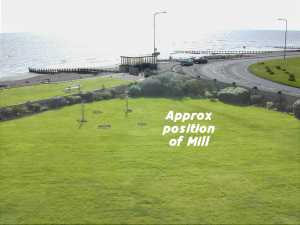Rustington
Sea Field Windmill
Our Windmill", was first noted in 1805 when the owner, Thomas Richardson took out an insurance policy for it. The following account and description was obtained from a website entitled "The Lost Windmills of Sussex" by Guy Blythman ..... "At one point the Graves brothers rented it from Richardson - one of them, George, was still at the mill in September 1820 when it was being offered for sale, but the Sussex Weekly Advertiser states that he has been given notice to quit the following year. However the Tithe Map of 1839 gives George Graves as owner, suggesting that he remained at the mill after all and eventually came into possession. It appears to have passed to his family on his death, for William Graves was miller in 1851, 1855 and 1858. In 1865 the mill, then being run by Graves' widow, narrowly escaped destruction when tail winded; the brake broke, three of the sweeps were destroyed and the mill nearly set on fire. This was a blow to Mrs. Graves, who had only recently been bereaved and had a very large family to support. (The report of the incident in the West Sussex Gazette of 8th June gives her name as "Greaves"). At some point in the 1850s Charles Albert Bailey, who also worked the tower mill at Littlehampton, became miller, remaining in the post for forty years or so up to 1908, when a firm named Messrs. Ashby and Son took it over.

Said to have originally been painted white, Sea Field was a tarred post mill with a single-storey roundhouse, four double-shuttered patent sails with the weight wheel and box on the right side of the tail and a six-bladed fantail mounted on the tailpole. It drove two pairs of stones. An oil painting of the mill, by Maurice Russell of Walberton, provides an interesting example of how artistic licence may mislead researchers. The painting shows wheels on the fan carriage, and one on the tailpole to give it extra support, but there are none on the steps, which are instead provided with a lever for lifting them as in a manually winded post mill. This seems highly unlikely to me, as the weight of the fan carriage and its wheels would make raising the whole assembly an arduous process, and the fan could not work in any case if the steps were levered up.... "
(Guy Blythman)
The Sea Field Mill, 1910

Copyright Mary Taylor (Rustington - A Pictorial History)
The Sea Field Mill is of particular interest in that it was at the south western corner of Lower Sea Field, the land on which the Estate was subsequently built in the mid 1960's. The mill was damaged by a storm in March 1912 and did not work again. The damage may not have been too severe since all four sweeps were still on at the time of demolition in 1913, but it was not repaired presumably due to a slump in the mill's trade.
Where it used to be

... Moving on to the present day, interestingly, the foundations of the mill can still be detected in periods of mid summer drought by the occurence of brown patches of scorched lawn just south-west of Beaufort Court right where the mill would have stood. It is assumed that the contractors employed by the Metropolitan Asylum Board who built the Convalescent Home and owned the land in 1913 didn't do a very thorough job of removing the foundations!
Read more on Sussex windmills.